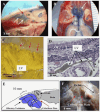Hydrocephalus: A Review of Etiology-Driven Treatment Strategies
- PMID: 39364470
- PMCID: PMC11448269
- DOI: 10.7759/cureus.68516
Hydrocephalus: A Review of Etiology-Driven Treatment Strategies
Abstract
Hydrocephalus is a broad term usually understood as cerebrospinal fluid (CSF) accumulation resulting in cerebral ventricular system expansion. The production of CSF is by the choroid plexus in lateral ventricles, flowing between the third and fourth ventricles and eventually to the subarachnoid space. It is critical for proper neuronal function. Hydrocephalus is a neurological pathology linked to high morbidity from neurocognitive and motor impairment. It is classified as either communicating or non-communicating. Communicating hydrocephalus is understood as a deficit at cranial arachnoid villi and granulation absorption sites. However, there has been evidence that extracranial lymphatic vessels in the ethmoid bone region also play a role, as indicated by decreased lymphatic absorption in rat models of hydrocephalus. Treatment typically involves surgical shunt placement or endoscopic third ventriculostomy (ETV) technique with or without choroid plexus cauterization (CPC). These surgical interventions have high failure risks and complications that require re-intervention, further increasing morbidity and mortality risks. To date, there are few nonsurgical treatment strategies, but many have proved limited benefit, and many patients still require surgery. This analysis lays out the typical treatments and explores new, innovative interventions by highlighting the active role of brain parenchymal tissue in the pathogenesis of hydrocephalus.
Keywords: beta-integrins; choroid plexus; intracranial pressure; parenchymal pressure; ventricular pressure.
Copyright © 2024, Mirkhaef et al.
Conflict of interest statement
Conflicts of interest: In compliance with the ICMJE uniform disclosure form, all authors declare the following: Payment/services info: All authors have declared that no financial support was received from any organization for the submitted work. Financial relationships: All authors have declared that they have no financial relationships at present or within the previous three years with any organizations that might have an interest in the submitted work. Other relationships: All authors have declared that there are no other relationships or activities that could appear to have influenced the submitted work.
Figures

Similar articles
-
Comparison of hydrocephalus metrics between infants successfully treated with endoscopic third ventriculostomy with choroid plexus cauterization and those treated with a ventriculoperitoneal shunt: a multicenter matched-cohort analysis.J Neurosurg Pediatr. 2018 Apr;21(4):339-345. doi: 10.3171/2017.10.PEDS17421. Epub 2018 Feb 2. J Neurosurg Pediatr. 2018. PMID: 29393809
-
Endoscopic third ventriculostomy and choroid plexus cauterization in infant hydrocephalus: a prospective study by the Hydrocephalus Clinical Research Network.J Neurosurg Pediatr. 2018 Mar;21(3):214-223. doi: 10.3171/2017.8.PEDS17217. Epub 2017 Dec 15. J Neurosurg Pediatr. 2018. PMID: 29243972
-
Predictors of endoscopic third ventriculostomy ostomy status in patients who experience failure of endoscopic third ventriculostomy with choroid plexus cauterization.J Neurosurg Pediatr. 2019 Jul 1;24(1):41-46. doi: 10.3171/2019.2.PEDS18743. Epub 2019 Apr 19. J Neurosurg Pediatr. 2019. PMID: 31003223
-
Clinical outcomes in pediatric hydrocephalus patients treated with endoscopic third ventriculostomy and choroid plexus cauterization: a systematic review and meta-analysis.J Neurosurg Pediatr. 2022 May 6;30(1):18-30. doi: 10.3171/2022.3.PEDS21512. Print 2022 Jul 1. J Neurosurg Pediatr. 2022. PMID: 35523256 Review.
-
Cerebrospinal fluid hypersecretion in pediatric hydrocephalus.Neurosurg Focus. 2016 Nov;41(5):E10. doi: 10.3171/2016.8.FOCUS16278. Neurosurg Focus. 2016. PMID: 27798982 Review.
References
-
- Koleva M, De Jesus O. StatPearls [Internet] Treasure Island, FL: StatPearls Publishing; 2023. Hydrocephalus.
-
- Global hydrocephalus epidemiology and incidence: systematic review and meta-analysis. Dewan MC, Rattani A, Mekary R, et al. J Neurosurg. 2019;130:1065–1079. - PubMed
Publication types
LinkOut - more resources
Full Text Sources
